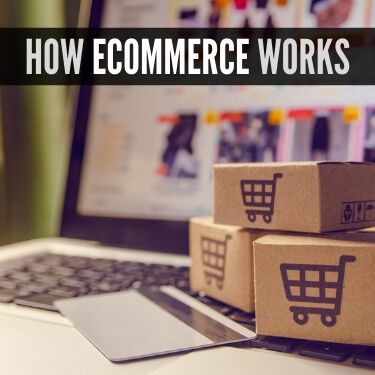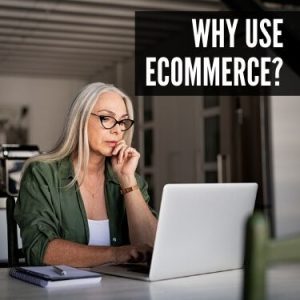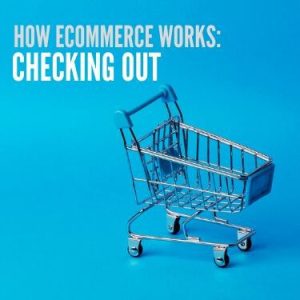
 Copy URL to Clipboard
Copy URL to Clipboard
Since a lot of the processes happen behind the scenes, understanding how eCommerce works can be a difficult task. Online retailers must make many legal and ethical decisions about protecting the privacy of online shoppers, and upholding the integrity of their brand. When a customer trusts a website with something as important as her credit card number, that website needs to take her privacy seriously. Even if a retailer would never use that private information anywhere else, hackers might be able to intercept the information if it is not encrypted.
There are many functions involved with the eCommerce process, including the website, the payment gateway, warehousing, fulfillment, delivery, and returns. If you don’t know how eCommerce works, you might not be able to help your customers if something goes wrong with their order.
Table of Contents

Buying online gives customers the ability to buy almost anything they want, from shoes to groceries to laptops, right from the comfort of their homes. This convenience makes it a tempting offer for just about everyone to try at least once. In fact, 96% of all Americans have made an online purchase at least once in their lives, while 79% shop online regularly. Businesses that do not have an online component to their stores could be missing out on potentially billions of dollars of sales!
There’s no denying the appeal of buying something without leaving your house and having someone else bring it to you. More and more people today are starting to prefer online shopping when compared to more conventional methods. However, despite the opportunity that the online market presents, a shocking 46% of small-scale retail businesses don’t even have a website, let alone an online store.
The past decade has started ushering in a new type of eCommerce that is focused on the increased use of mobile devices. Now, customers can buy anything right from their smartphone, just as easily as they can on their computers. This mobile commerce is opening many more opportunities for businesses, but it also comes with its fair share of problems. Companies have to implement new technologies in order to track mobile website visitors, and reformat the site for the smaller screen.
With the growing influence of the millennial generation, online retailing is gaining more influence in the retail market as a whole. When polled, millennials admitted to making 54% of all their purchases online, as opposed to in store. Modern technology makes the process time efficient and convenient, which is also a plus for busy people. Because of this, the profit margins for online retailing is skyrocketing, growing on average 23% every year.
Retail businesses are quickly turning their attention to the online market, and its potential for increased sales. The convenience of online shopping gives it a good reputation, but that barely scratches the surface of the list of benefits. The biggest benefit is that selling online can help to supplement or encourage sales from a physical location, by vastly widening its area of influence. People that had previously never been able to visit the store’s physical location would now be able to order items online. This greatly increases a business’s customer base, by reaching a much wider audience than before.
Most of the benefits of eCommerce are not dependent on supplementing a physical location, and can be applied to any online retail store. Having an online store gives customers the opportunity to browse products at any time during the day or night, and place an order whenever it is convenient for them. Not only that, the process is fast. Customers can get online, find something they like, add it to their cart, and checkout in less time than it would take to drive to a store. Then customers can simply forget about the order and do other things until it shows up in their driveway. Also, not only is it easy for customers to use, it is easier for businesses to manage since everything is online and easily monitored.
The most important thing to understand about how eCommerce works is that it must happen online, through a website. The website is where all the goods or services will be listed for sale, and it is important for it to leave a good impression on the customers. In addition to that, the website must be compliant with regulations to ensure that no legal issues will arise as a result of people trusting the site with their personal payment information.
A successful website needs to do more than just list products or services. It has to be user-friendly, and it has to actually look good, to put it simply. If there are confusing tabs or subpages, or the organization of the site doesn’t make any sense, then a customer is likely to get fed up and abandon the site. Branding is also an important part of designing the website, especially if the online store is meant to supplement an existing physical store. Brands and logos can be used to steer the color design of the website, as long as it doesn’t get out of hand and end up flashy. Even if the site is organized well, 38% of people will leave anyway if the layout is an eyesore.
Once the website has a solid design, it must be secured with an SSL certificate to be compliant with the Payment Card Industry Data Security Standard (PCI DSS). The PCI DSS ensures that websites protect the private information of their customers, like addresses and credit card numbers. An SSL certificate works by encrypting personal information as complete nonsense, and only enabling certain people to be able to unlock that information. These people are typically the person that the information applies to, and the bank involved with the sale. No one else, not even the business selling the goods or services, can unlock and view the encrypted data. Even if it is intercepted by hackers, it cannot be decoded.
A viewer on the site can tell if it has been SSL certified, because a small green lock will appear next to the search bar, with the word “secure.” The hhtp:// at the beginning of the website URL will become https://, with the additional “s” standing for “secure” as well. This makes secure sites quickly and easily recognizable, which helps customers to trust the authenticity of the website. If a customer trusts that their information will not be recorded or misused, then they are far more likely to go through with a purchase.
In some cases, customers can save their information in a site for quick access with the help of a customer account. This can make it more convenient to make repeated purchases, and opens up the opportunity for other benefits. Visitors to the site will be prompted to sign up with a username, password, and a valid email. There are many things that a business owner can offer through customer accounts, both to increase sales and to reward loyal customers.
Customer accounts can open the avenue of email advertising, updates on new releases, discounts for members, and rewards programs. Money back or point systems are popular choices for rewarding returning customers, and encouraging future sales. Customers will want to redeem any rewards they are given. However, despite the benefits of having a customer account, some people will only wish to make a single purchase, and won’t need or want the member’s benefits. These customers may get frustrated if a membership is a requirement for purchase.

There is almost no limit to what can be sold online. The convenience of being able to shop from an endless variety of items without ever leaving home makes it difficult for brick-and-mortar business models to compete. While some people still prefer to physically shop for their goods, the added convenience of being able to buy and sell anything around the world is making it seem more favorable.
So say there’s a customer looking for merchandise for a popular cartoon. While browsing the internet from her home, she discovers that there is an official merchandise store online. When she pulls up the website, the cartoon characters decorate the banner at the top of the page, giving it an authentic brand feel. The customer can then pick the kind of merchandise she wants with the help of navigation links.
This hypothetical store happens to sell stickers, buttons, t-shirts, and mugs. The customer selects the stickers tab, and starts browsing through the stickers until she finds one she likes. She selects the one she wants and a new web page opens up that is specific to that item, with product details, customer reviews, and costs. The customer decides to buy it, so she clicks on the “add to cart button.” However, she decides that she wants to shop around a bit more before checking out, and maybe add some more items to her shopping cart.
Businesses utilize what’s known as an Order Management System (OMS) to handle all processes dealing with customer orders, like the one above. OMSs are software programs that integrate with other aspects of the business, to make things easier. Some aspects that may use or influence the OMS include sales, marketing, customer service, and inventory management. Not only does it keep track of the product stock to keep the website accurate and updated, but it also deals with forecasting demand, processing payments, and communicating with warehouses to replenish stock. Although an OMS is not necessary for a smaller business to operate well, bigger eCommerce businesses may fall behind without one.

Let’s get back to our customer. She has finished shopping around and now goes into her shopping cart. Here, she can review the things she has selected, see a total price including tax and shipping, and remove items she may have changed her mind about buying. Countless potential buyers abandon the site at this stage, but sometimes email reminders or even just time will cause them to return to the page to complete the order. The cart will always be waiting for each person exactly as they left it, ready to finish the orders. When our customer decides she is satisfied with her shopping cart, she clicks on the “buy” button to move on to the next step.
When the customer hits “buy,” a popup or new page on the site comes up to prompt her to make a choice for her payment. Not all sites offer every option, but common options include credit or debit cards, gift cards, PayPal, redeemable rewards, or an online balance. She is never directed away from the secure website, so she knows she can feel comfortable putting in her information. She opts to use her credit card to complete the transaction this time. She is prompted to fill in her card information and her address, and then a promo code or coupon if she has one. Accepting coupons and promo codes is generally a simple function that is programmed into the site, which automatically deducts a set amount or percentage off her bill.
After she submits her payment information, all that is left for her to do is wait for the order to show up at her door. Behind the scenes, however, many more processes must be completed in order to make that happen.
Immediately after the order is placed, the transaction is authorized. This is to ensure that the transaction is valid, there is money in the account, and the card is not expired. This happens within seconds of the customer confirming the order. Then, a popup will appear on the page to inform the customer of whether her card was authorized or declined. Assuming it was authorized without issue, the customer will be sent a confirmation email and an online receipt. No further action is required from her, but the email receipt is useful if a problem arises with shipping, or if the products need to be returned.
After the transaction has been authorized, the payment must be processed. This can take several days to complete, but the sale is allowed to continue as long as there are no major problems with the transaction at this point. The money from the transaction sits in a Merchant Account in the meantime, since it cannot be transferred to the business until it has been processed. The payment information is encrypted and sent to the cardholder’s bank for processing, via a Secure Payment Gateway. This is made possible by the website’s SSL Certification, and it keeps the money and the information safe from anyone not involved with the transaction.
The customer’s bank processes the funds and confirms that everything is correct, before allowing the transfer of the funds from the Merchant Account to a personal or company account. In order to transfer the funds, the business owner must have a Merchant ID to prove that he or she is responsible for the Merchant Account in question. Once this goes through, the “pending transaction” notice in the customer’s bank account will disappear, and the money will officially belong to the business or business owner.

The next step in the process of how eCommerce works is preparing the item for shipment. This is much easier when working with a Third-Party Logistics (3PL) company, which removes the responsibility from the business owner. A 3PL company can work seamlessly with the rest of the business to make things easier, so business owners can focus on growing their eCommerce business.
The eCommerce store’s OMS has a direct link to the Warehouse Management System (WMS) in the 3PL distribution center, which controls all operations on the fulfillment side. A distribution center is like a warehouse, but with many more features that make it ideal for eCommerce. Not only does the WMS make quick and accurate communication between parties possible, it also tracks shipments, monitors stock, and optimizes distribution center organization. It streamlines the process of storage and fulfillment, making it easy to integrate with an existing OMS or eCommerce site. Because of this streamlining, the distribution center is able to receive an exact list of the items that the customer ordered, directly from their database to avoid human error.
When the distribution center fulfillment team receives the order, they can see that the customer has paid for three stickers, two t-shirts, and one mug. At this point, the different parts of the order are in different places in the distribution center, but they can be found quickly using the WMS database. It shows the exact location of each product in the distribution center at the click of a button, sometimes even on a map of the warehouse floor plan. Three workers move off in the direction of the three different items, and they meet by the loading dock to pack the items together in the same box for shipment. This process is called Pick-and-Pack shipping, because workers pick the individual items off the shelves from larger boxes, and pack them together in one smaller box. That’s not the only service offered by distribution centers, however. They also offer replenishment services, breakbulk, cross-docking, transportation, warehousing, and kitting options to fully accommodate any eCommerce business to meet their customers’ needs.
After the order is packaged, it is loaded into a freight truck with other packages going to the same delivery center. The moment the truck leaves the distribution center, an email is sent out to notify the customer. The email typically includes a tracking number, which she can input into the website. The advanced technology allows her to track where her package is, where it has been, and where it is going. It will also give her an estimated or even guaranteed time of delivery. She can watch the online module that shows when the package moves from the distribution center, to the delivery center, to the delivery truck, all the way up to when it gets to her door. At that point, another email is sent out to confirm that the order has been delivered safely and correctly.
Sometimes, that’s the end of the journey for packages. Other times, orders will need to be returned for one reason or another. There are many reasons for a customer to want to return something. Maybe the color looks different in person, or the size isn’t what they were hoping for. Maybe the product doesn’t work as expected, or maybe it’s even broken. Sometimes businesses have to order recalls on items too, in the event of faulty manufacturing. No business wants to think about something going wrong, but that doesn’t mean the possibility for returns should be ignored.
Returns happen, so it’s important to have a policy in place for accepting them. By outsourcing warehouse operations with a 3PL, Reverse Logistics services come as part of the deal. The 3PL company handles receiving the returned package, refunding the customer or replacing the items, and choosing the best course of action for the returned goods. 3PLs understand how ecommerce works, to ensure that the customer has a good experience no matter what happens with the shipment.
If you have a large inventory of online merchandise, then you’re probably swamped with work. Trying to manage inventory, storage, and fulfillment while running an online store is a huge task for anyone. If you’re ready to free up your time again to focus on your business, then outsourcing inventory management such as warehousing and fulfillment to R+L Global Logistics is the way to go. We’re experts in how eCommerce works and we help thousands of small business owners fulfill online orders on a daily basis. In our warehouses, you’ll have access to features like:
What are you waiting for? Let us take this extra work off your hands. We’ll work with you to find a solution for your specific situation, and we can scale up operations as your business grows! Contact us today at (866) 989-3082 or chat at the bottom right of the screen so we can find a solution that meets your needs.
